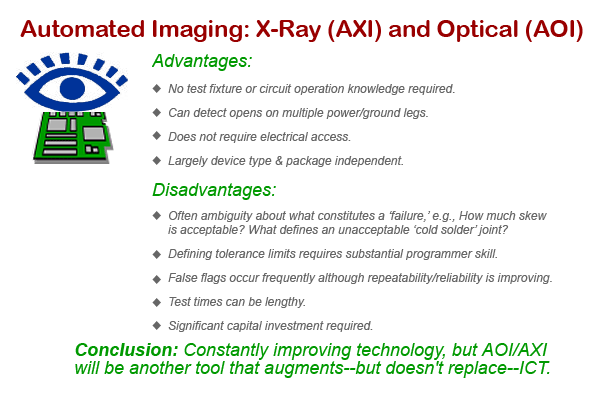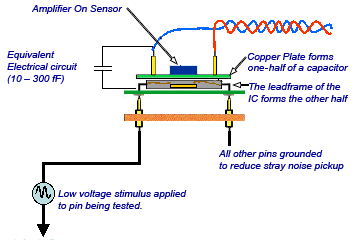Roll your mouse over the topics in the column at the right for a quick review of testing techniques for ICs on boards, their advantages and disadvantages.

Testing ICs on Circuit Boards (In-Circuit Test): a brief tutorial

Delivers High Fault Coverage for the Least Cost
Opens around ICs–whether pins or internal problems–are the most prevalent fault class on virtually every SMT manufacturing floor. If you’re in circuit testing boards but skipping vectorless test you’re either wasting money, adversely impacting board quality–or both.
Power-off vectorless test is superior to classical digital vector test (aka „backdrive” test) in just about every IC testing situation. And TestJet is the most widely used vectorless test technology in the world.
But if you’re still using traditional 'big iron’ in circuit testers like Agilent and Teradyne to program and perform vectorless test you’re spending too much. Why?
Why CheckSum Analyst systems are your best tool for TestJet vectorless test
CheckSum Analyst systems use exactly the same TestJet Technology originally introduced by Hewlett-Packard (now Agilent) in 1994 and now used on thousands of in circuit testers worldwide. TestJet Technology reliably identifies opens around (and inside) almost any IC package with a lead frame or metallic pins or leads to which the TestJet probe can capacitively couple–an enormous variety of device types.
| Device Type / Package |
Use TestJet Technology? |
|
| Devices with an internal lead frame (most digital and hybrid devices) | Yes | |
| Devices with an internal ground plane (usually ceramic packages) | No | |
| Most Ball Grid Arrays (BGAs) (except ceramic and stadium packages) | Yes | |
| Some Ball Grid Arrays (CBGAs) (ceramic and stadium packages only | No | |
| Connectors and sockets | Yes | |
| Devices with grounded heat sink | No | |
| Flip chip devices or chip-on-board | No | |
| DIP switches | Yes | |
| Pushbuttons | No |
TestJet Technology is the ideal match to Analyst’s low cost and ease of application. Unburdened by expensive digital vector hardware and software, Analyst systems equipped with TestJet Technology create an unbeatable combination of low applications (fixture and test program) cost, fast throughput and high fault coverage.
The inside story: TestJet Technology
TestJet Technology examines the connectivity from each pin on a device to the circuit board. It does not require that power be applied to the device under test.
The TestJet hardware measures the capacitance from a pin of a device to the TestJet probe. The measured value is compared against preset limits by the Analyst system–just like any other in circuit test. If the capacitance falls below the lower tolerance an open pin exists. This measurement is repeated for each pin on the device except power and ground pins. Pins that are tied together are tested as one pin.

A specific test step is accomplished by connecting a low voltage AC stimulus source to the pin being tested, the Sense to the TestJet probe, and then to guard out (ground) all other pins on the device. The signal is amplified and filtered right at the TestJet probe to improve signal quality. Each TestJet probe is connected to a port on a system TestJet board that is mounted in the test system chassis. Depending on the specific test system configuration, up to 384, or more, TestJet probes can be connected to the test system.